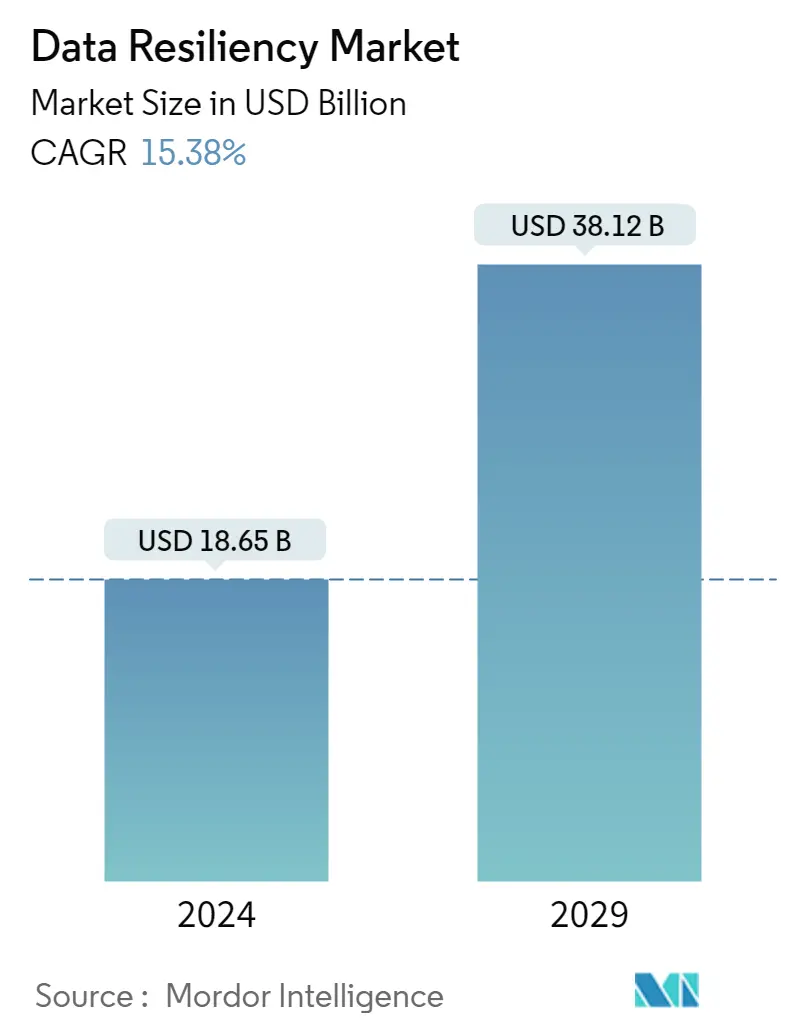Market Size of Data Resiliency Industry

| Study Period | 2019 - 2029 |
| Market Size (2024) | USD 18.65 Billion |
| Market Size (2029) | USD 38.12 Billion |
| CAGR (2024 - 2029) | 15.38 % |
| Fastest Growing Market | Asia Pacific |
| Largest Market | North America |
| Market Concentration | Medium |
Major Players
*Disclaimer: Major Players sorted in no particular order |
Data Resiliency Market Analysis
The Data Resiliency Market size is estimated at USD 18.65 billion in 2024, and is expected to reach USD 38.12 billion by 2029, growing at a CAGR of 15.38% during the forecast period (2024-2029).
With the rapidly increasing penetration of the internet among developed and developing countries, also the expanding wireless network for all the mobile devices has primarily increased the vulnerability of data, which is expected to make data resiliency an essential and integral part of every single organization across the globe.
- The previous year has seen a rapid increase in the number of cyberattacks. This has forced companies to adopt security-first thinking. The service providers are now putting much more effort in order to secure the service infrastructure of their clients. The solutions are not only about having a security solution in place but also the ability to defend and recover fast against any type of attack.
- Enterprises and government organizations across the globe are moving from test environments to placing more of their work-critical workloads and compute instances into the cloud. Further, owing to the rapidly increasing adoption of IoT, cloud, and big data analytics across multiple organizations as a major part of their digital transformation strategy, the burden on the data centers is also increasing leading to the growth of the market.
- According to Datrium Inc. report, 'The State of Enterprise Data Resiliency and Disaster Recovery 2019, more than 50% of the respondents indicated that their organization experienced a DR event in the past 24 months. Moroever, 89% of the IT leaders reported that ransomware is the major threat to organizations' data security. The IT leaders also expressed that their top concerns regarding this was the loss of productivity (74%) and the inability to operate their businesses (65%) under these circumstances.
- Whether on-premise, public, private, or a hybrid model, the move towards a multi-cloud architecture is increasingly becoming popular. A research from Teradici Corporation has revealed that more than half of the IT professionals are currently operating in a multi-cloud environment, with almost one in every ten using five or more clouds within their organizations.
- Various enterprises across the globe are currently focused on managing the impact of the coronavirus pandemic and are looking at newer and robust practices in order to help ensure their business resiliency now and during any other future disruptive events. A proactive business continuity and resiliency strategy is becoming very crucial to enable digital businesses, which primarily requires building a robust resiliency into the infrastructure, while reducing downtime and associated costs.
Data Resiliency Industry Segmentation
The data resiliency solutions are being adopted to prevent the data loss in an unexpected failure or a malicious event, the major importance of these resiliency solutions is being able to recover the data at or near the original state when any unexpected event occurs as quickly as possible. In the current times of ransomware, data protection and disaster recovery are increasingly being taken up as a new prominence in the IT landscape.
| By Deployment | |
| On-premise | |
| Cloud |
| By End-user Vertical | |
| BFSI | |
| IT & Telecommunication | |
| Government | |
| Manufacturing | |
| Healthcare | |
| Other End-user Vertical |
| Geography | |
| North America | |
| Europe | |
| Asia-Pacific | |
| Latin America | |
| Middle East & Africa |
Data Resiliency Market Size Summary
The Data Resiliency Market is poised for significant growth, driven by the increasing vulnerability of data due to the rapid expansion of internet and wireless networks globally. As cyberattacks become more frequent, organizations are compelled to adopt a security-first approach, emphasizing the need for robust data resiliency solutions. This shift is further accelerated by the migration of critical workloads to the cloud and the growing adoption of IoT, cloud, and big data analytics as part of digital transformation strategies. The market is witnessing a transition towards multi-cloud architectures, with enterprises and government organizations prioritizing business continuity and resiliency to mitigate the impact of disruptive events. The financial sector, in particular, is a major driver of market demand, as it faces numerous data breaches and cyber threats, necessitating the implementation of advanced technologies to secure sensitive information and comply with regulatory requirements.
The North American region stands out as a key hub for data resiliency solutions, fueled by the rapid growth of connected devices and the increasing risks of cyberattacks. The region's demand for resiliency solutions is bolstered by the need to protect critical data across various sectors, including healthcare, which has recently experienced ransomware attacks. The competitive landscape of the Data Resiliency Market is characterized by the presence of multiple vendors, with companies like IBM, Microsoft, and NetApp leading the charge through product innovation and strategic partnerships. Recent developments, such as Commvault's agreement with Microsoft and Acronis' partnership with ACE Pacific Group, highlight the ongoing efforts to enhance data protection capabilities across cloud and on-premise environments. These strategic moves are indicative of the market's dynamic nature and the continuous pursuit of advanced solutions to address evolving data security challenges.
Data Resiliency Market Size - Table of Contents
-
1. MARKET DYNAMICS
-
1.1 Market Overview
-
1.2 Market Drivers
-
1.2.1 Rapid Growth in Data being Generated from Multiple Sources
-
1.2.2 Increasing Privacy Concerns and Rising Need for Data Security
-
-
1.3 Market Restraints
-
1.3.1 Availability of open-source alternatives
-
-
1.4 Porters 5 Force Analysis
-
1.4.1 Threat of New Entrants
-
1.4.2 Bargaining Power of Buyers/Consumers
-
1.4.3 Bargaining Power of Suppliers
-
1.4.4 Threat of Substitute Products
-
1.4.5 Intensity of Competitive Rivalry
-
-
-
2. MARKET SEGMENTATION
-
2.1 By Deployment
-
2.1.1 On-premise
-
2.1.2 Cloud
-
-
2.2 By End-user Vertical
-
2.2.1 BFSI
-
2.2.2 IT & Telecommunication
-
2.2.3 Government
-
2.2.4 Manufacturing
-
2.2.5 Healthcare
-
2.2.6 Other End-user Vertical
-
-
2.3 Geography
-
2.3.1 North America
-
2.3.2 Europe
-
2.3.3 Asia-Pacific
-
2.3.4 Latin America
-
2.3.5 Middle East & Africa
-
-
Data Resiliency Market Size FAQs
How big is the Data Resiliency Market?
The Data Resiliency Market size is expected to reach USD 18.65 billion in 2024 and grow at a CAGR of 15.38% to reach USD 38.12 billion by 2029.
What is the current Data Resiliency Market size?
In 2024, the Data Resiliency Market size is expected to reach USD 18.65 billion.

